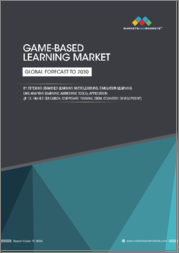
|
시장보고서
상품코드
1722363
세계의 마이크로러닝 시장 : 규모, 점유율, 성장 분석, 컴포넌트별, 조직 유형별, 전개 유형별, 최종 사용자 산업별, 지역별 산업 예측(2025-2032년)Microlearning Market Size, Share, and Growth Analysis, By Component (Solution, Services), By Organization Type (Large Enterprises, SMES), By Deployment Type, By End User Industry, By Region - Industry Forecast 2025-2032 |
||||||
세계의 마이크로러닝 시장 규모는 2023년 26억 5,000만 달러로 평가되었고, 2024년 30억 1,000만 달러에서 2032년까지 82억 2,000만 달러로 성장해 예측 기간 중(2025-2032년) CAGR 13.4%를 나타낼 것으로 보입니다.
마이크로러닝 시장은 효과적이고 유연한 학습 솔루션에 대한 수요가 증가함에 따라 세계적으로 큰 성장을 이루고 있습니다. 동시에, 신흥 시장에서는 스마트폰이나 인터넷의 보급이 진행되고, 모바일 앱을 통한 마이크로러닝의 전달이 보급되고 있습니다. 그러나 제한된 컨텐츠 범위, 표준화의 부족, 보다 광범위한 학습 목표와의 일관성 등의 과제가 성장의 방해가 될 가능성이 있습니다. 이러한 장애에도 불구하고, 기술의 진보는 계속되고 있어 마이크로러닝의 이점에 대한 인식도 높아지고 있기 때문에 장기적인 시장 확대가 기대됩니다.
목차
소개
- 조사의 목적
- 조사 범위
- 정의
조사 방법
- 정보 조달
- 2차와 1차 데이터의 방법
- 시장 규모 예측
- 시장의 전제조건과 제한
주요 요약
- 세계 시장 전망
- 공급과 수요 동향 분석
- 부문별 기회 분석
시장 역학과 전망
- 시장 개요
- 시장 규모
- 시장 역학
- 성장 촉진요인과 기회
- 억제요인과 과제
- Porter's Five Forces 분석
주요 시장 인사이트
- 중요성공요인
- 경쟁도
- 주요 투자 기회
- 시장 생태계
- 시장의 매력 지수(2024년)
- PESTEL 분석
- 거시경제지표
- 밸류체인 분석
- 가격 분석
- 기술의 진보
- 사례 연구
마이크로러닝 시장 규모 : 컴포넌트별 CAGR(2025-2032년)
- 시장 개요
- 솔루션
- 서비스
- 컨설팅 및 구현
- 지원 및 유지 보수
마이크로러닝 시장 규모 : 조직 유형별 CAGR(2025-2032년)
- 시장 개요
- 대기업
- 중소기업
마이크로러닝 시장 규모 : 전개 유형별 CAGR(2025-2032년)
- 시장 개요
- On-Premise
- 클라우드
마이크로러닝 시장 규모 : 최종 사용자 산업별 CAGR(2025-2032년)
- 시장 개요
- 소매
- 제조 및 물류
- BFSI
- 통신 및 IT
- 헬스케어 및 생명과학
- 기타
- 교육
- 여행 및 접객
- 미디어 및 엔터테인먼트
- 에너지 및 유틸리티
마이크로러닝 시장 규모 : 지역별 CAGR(2025-2032년)
- 북미
- 미국
- 캐나다
- 유럽
- 독일
- 스페인
- 프랑스
- 영국
- 이탈리아
- 기타 유럽
- 아시아태평양
- 중국
- 인도
- 일본
- 한국
- 기타 아시아태평양
- 라틴아메리카
- 브라질
- 기타 라틴아메리카
- 중동 및 아프리카
- GCC 국가
- 남아프리카
- 기타 중동 및 아프리카
경쟁 정보
- 상위 5개사 비교
- 주요 기업의 시장 포지셔닝(2024년)
- 주요 시장 기업이 채용한 전략
- 최근 시장 동향
- 기업의 시장 점유율 분석(2024년)
- 주요 기업의 기업 프로파일
- 기업의 상세
- 제품 포트폴리오 분석
- 기업의 부문별 점유율 분석
- 수익의 전년대비 비교(2022-2024년)
주요 기업 프로파일
- Duolingo(USA)
- Skillsoft(USA)
- Coursera(USA)
- Udemy(USA)
- Docebo(Canada)
- Pearson plc(UK)
- NIIT Limited(India)
- OpenLearning Limited(Australia)
- BTS Group AB(Sweden)
- 2U, Inc.(USA)
- Chegg, Inc.(USA)
- Perdoceo Education Corporation(USA)
- Strategic Education, Inc.(USA)
- Adtalem Global Education Inc.(USA)
- Grand Canyon Education, Inc.(USA)
결론과 권고
JHS 25.05.27Global Microlearning Market size was valued at USD 2.65 billion in 2023 and is poised to grow from USD 3.01 billion in 2024 to USD 8.22 billion by 2032, growing at a CAGR of 13.4% during the forecast period (2025-2032).
The microlearning market is experiencing substantial growth globally, driven by an increasing demand for effective, flexible learning solutions. Corporations and educational institutions are embracing microlearning to enhance employee training, reduce time requirements, and improve knowledge retention. Concurrently, rising smartphone and internet penetration in emerging markets facilitates widespread delivery of microlearning through mobile apps. Schools and universities are also integrating microlearning to complement traditional education, offering learners more independence. However, challenges such as limited content scope, lack of standardization, and alignment with broader learning goals could hinder growth. Resistance to new learning models and concerns over data privacy further complicate adoption. Despite these obstacles, ongoing technological advancements and a growing recognition of microlearning's benefits are expected to drive long-term market expansion.
Top-down and bottom-up approaches were used to estimate and validate the size of the Global Microlearning market and to estimate the size of various other dependent submarkets. The research methodology used to estimate the market size includes the following details: The key players in the market were identified through secondary research, and their market shares in the respective regions were determined through primary and secondary research. This entire procedure includes the study of the annual and financial reports of the top market players and extensive interviews for key insights from industry leaders such as CEOs, VPs, directors, and marketing executives. All percentage shares split, and breakdowns were determined using secondary sources and verified through Primary sources. All possible parameters that affect the markets covered in this research study have been accounted for, viewed in extensive detail, verified through primary research, and analyzed to get the final quantitative and qualitative data.
Global Microlearning Market Segments Analysis
Global Microlearning Market is segmented by Component, Organization Type, Deployment Type, End User Industry and region. Based on Component, the market is segmented into Solution and Services. Based on Organization Type, the market is segmented into Large Enterprises and SMES. Based on Deployment Type, the market is segmented into On-Premises and Cloud. Based on End User Industry, the market is segmented into Retail, Manufacturing and Logistics, BFSI, Telecom and It, Healthcare and Life Sciences and Others. Based on region, the market is segmented into North America, Europe, Asia Pacific, Latin America and Middle East & Africa.
Driver of the Global Microlearning Market
The global microlearning market is significantly driven by the rising adoption of mobile learning, which enhances accessibility and convenience for learners. With over 6.8 billion mobile phone users worldwide, these mobile learning platforms are increasingly popular due to their easy usability and the ability for individuals to access educational content on smartphones and tablets. This trend is further propelled by continuous advancements in mobile technology, enabling learners to consume bite-sized educational material anytime and anywhere. As a result, microlearning effectively supports both permanent knowledge retention and flexible learning experiences, making it an essential component of modern education strategies.
Restraints in the Global Microlearning Market
The Global Microlearning market faces notable constraints, primarily stemming from a lack of awareness regarding the advantages of microlearning, as many organizations continue to depend on conventional training approaches. The cost-effectiveness, adaptability, and enhanced learning outcomes associated with microlearning are often overlooked. This deficiency in understanding can hinder organizations from fully realizing the benefits that microlearning can provide, such as boosting workforce productivity, enhancing skill development, and increasing overall learning effectiveness. As a result, the potential for organizations to leverage microlearning for improved training solutions remains unfulfilled, posing a significant challenge to market growth.
Market Trends of the Global Microlearning Market
The global microlearning market is experiencing a significant upward trend, driven by the surging demand for mobile-first learning solutions. With increasing smartphone penetration and internet accessibility, especially in developing regions like India, microlearning platforms are adapting to meet diverse educational needs. The Indian government's commitment of ₹500 crore in the 2025 Union Budget to bolster broadband connectivity in rural schools underscores the emphasis on bridging the digital divide and advancing inclusive education. As organizations and educational institutions prioritize efficient, bite-sized learning experiences, the global microlearning market is poised for substantial growth, fostering better engagement and knowledge retention among learners worldwide.
Table of Contents
Introduction
- Objectives of the Study
- Scope of the Report
- Definitions
Research Methodology
- Information Procurement
- Secondary & Primary Data Methods
- Market Size Estimation
- Market Assumptions & Limitations
Executive Summary
- Global Market Outlook
- Supply & Demand Trend Analysis
- Segmental Opportunity Analysis
Market Dynamics & Outlook
- Market Overview
- Market Size
- Market Dynamics
- Drivers & Opportunities
- Restraints & Challenges
- Porters Analysis
- Competitive rivalry
- Threat of substitute
- Bargaining power of buyers
- Threat of new entrants
- Bargaining power of suppliers
Key Market Insights
- Key Success Factors
- Degree of Competition
- Top Investment Pockets
- Market Ecosystem
- Market Attractiveness Index, 2024
- PESTEL Analysis
- Macro-Economic Indicators
- Value Chain Analysis
- Pricing Analysis
- Technological Advancement
- Case Studies
Global Microlearning Market Size by Component & CAGR (2025-2032)
- Market Overview
- Solution
- Services
- Consulting And Implementation
- Support And Maintenance
Global Microlearning Market Size by Organization Type & CAGR (2025-2032)
- Market Overview
- Large Enterprises
- SMES
Global Microlearning Market Size by Deployment Type & CAGR (2025-2032)
- Market Overview
- On-Premises
- Cloud
Global Microlearning Market Size by Industry & CAGR (2025-2032)
- Market Overview
- Retail
- Manufacturing And Logistics
- BFSI
- Telecom And It
- Healthcare And Life Sciences
- Others
- Education
- Travel And Hospitality
- Media And Entertainment
- Energy And Utilities
Global Microlearning Market Size & CAGR (2025-2032)
- North America (Component, Organization Type, Deployment Type, Industry)
- US
- Canada
- Europe (Component, Organization Type, Deployment Type, Industry)
- Germany
- Spain
- France
- UK
- Italy
- Rest of Europe
- Asia Pacific (Component, Organization Type, Deployment Type, Industry)
- China
- India
- Japan
- South Korea
- Rest of Asia-Pacific
- Latin America (Component, Organization Type, Deployment Type, Industry)
- Brazil
- Rest of Latin America
- Middle East & Africa (Component, Organization Type, Deployment Type, Industry)
- GCC Countries
- South Africa
- Rest of Middle East & Africa
Competitive Intelligence
- Top 5 Player Comparison
- Market Positioning of Key Players, 2024
- Strategies Adopted by Key Market Players
- Recent Developments in the Market
- Company Market Share Analysis, 2024
- Company Profiles of All Key Players
- Company Details
- Product Portfolio Analysis
- Company's Segmental Share Analysis
- Revenue Y-O-Y Comparison (2022-2024)
Key Company Profiles
- Duolingo (USA)
- Company Overview
- Business Segment Overview
- Financial Updates
- Key Developments
- Skillsoft (USA)
- Company Overview
- Business Segment Overview
- Financial Updates
- Key Developments
- Coursera (USA)
- Company Overview
- Business Segment Overview
- Financial Updates
- Key Developments
- Udemy (USA)
- Company Overview
- Business Segment Overview
- Financial Updates
- Key Developments
- Docebo (Canada)
- Company Overview
- Business Segment Overview
- Financial Updates
- Key Developments
- Pearson plc (UK)
- Company Overview
- Business Segment Overview
- Financial Updates
- Key Developments
- NIIT Limited (India)
- Company Overview
- Business Segment Overview
- Financial Updates
- Key Developments
- OpenLearning Limited (Australia)
- Company Overview
- Business Segment Overview
- Financial Updates
- Key Developments
- BTS Group AB (Sweden)
- Company Overview
- Business Segment Overview
- Financial Updates
- Key Developments
- 2U, Inc. (USA)
- Company Overview
- Business Segment Overview
- Financial Updates
- Key Developments
- Chegg, Inc. (USA)
- Company Overview
- Business Segment Overview
- Financial Updates
- Key Developments
- Perdoceo Education Corporation (USA)
- Company Overview
- Business Segment Overview
- Financial Updates
- Key Developments
- Strategic Education, Inc. (USA)
- Company Overview
- Business Segment Overview
- Financial Updates
- Key Developments
- Adtalem Global Education Inc. (USA)
- Company Overview
- Business Segment Overview
- Financial Updates
- Key Developments
- Grand Canyon Education, Inc. (USA)
- Company Overview
- Business Segment Overview
- Financial Updates
- Key Developments















